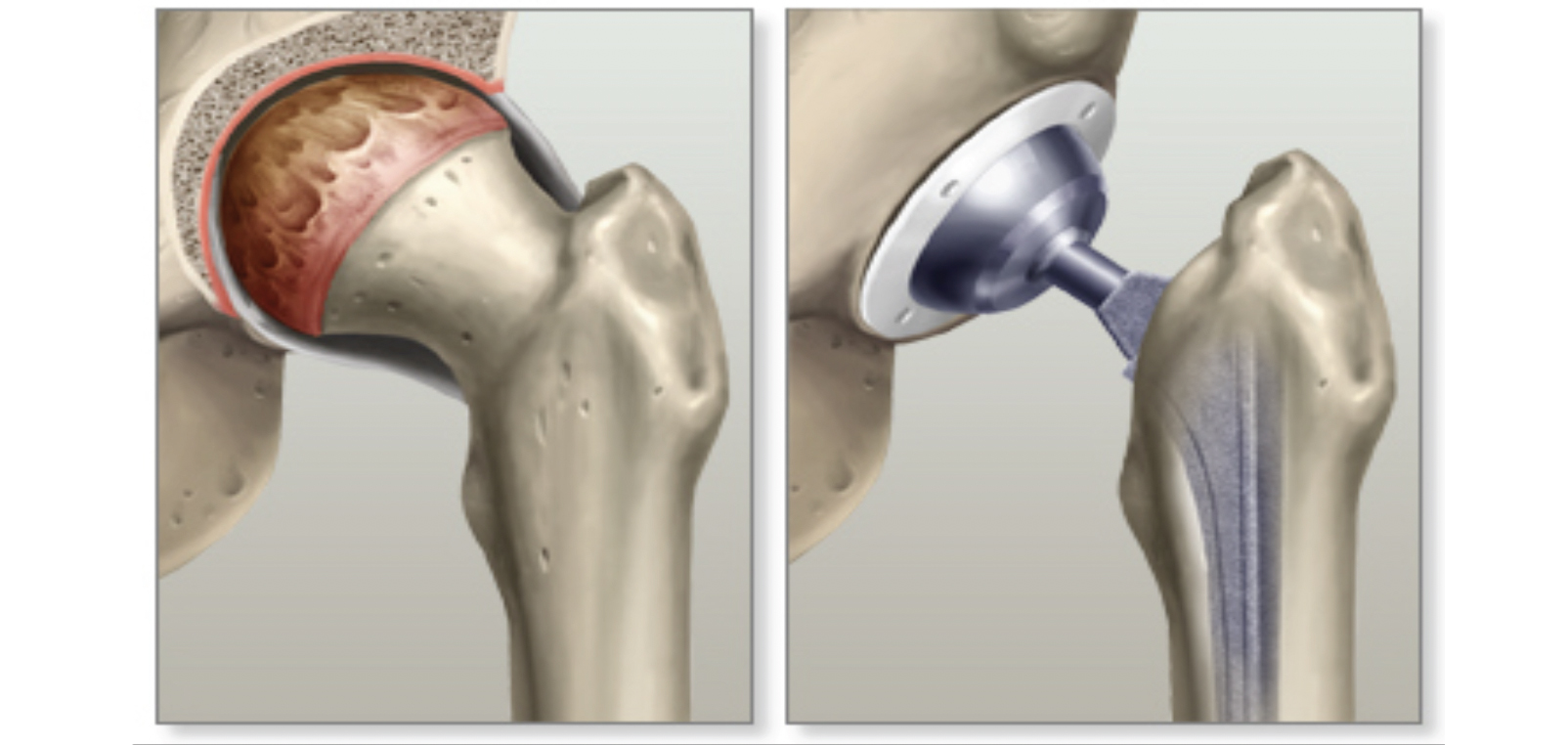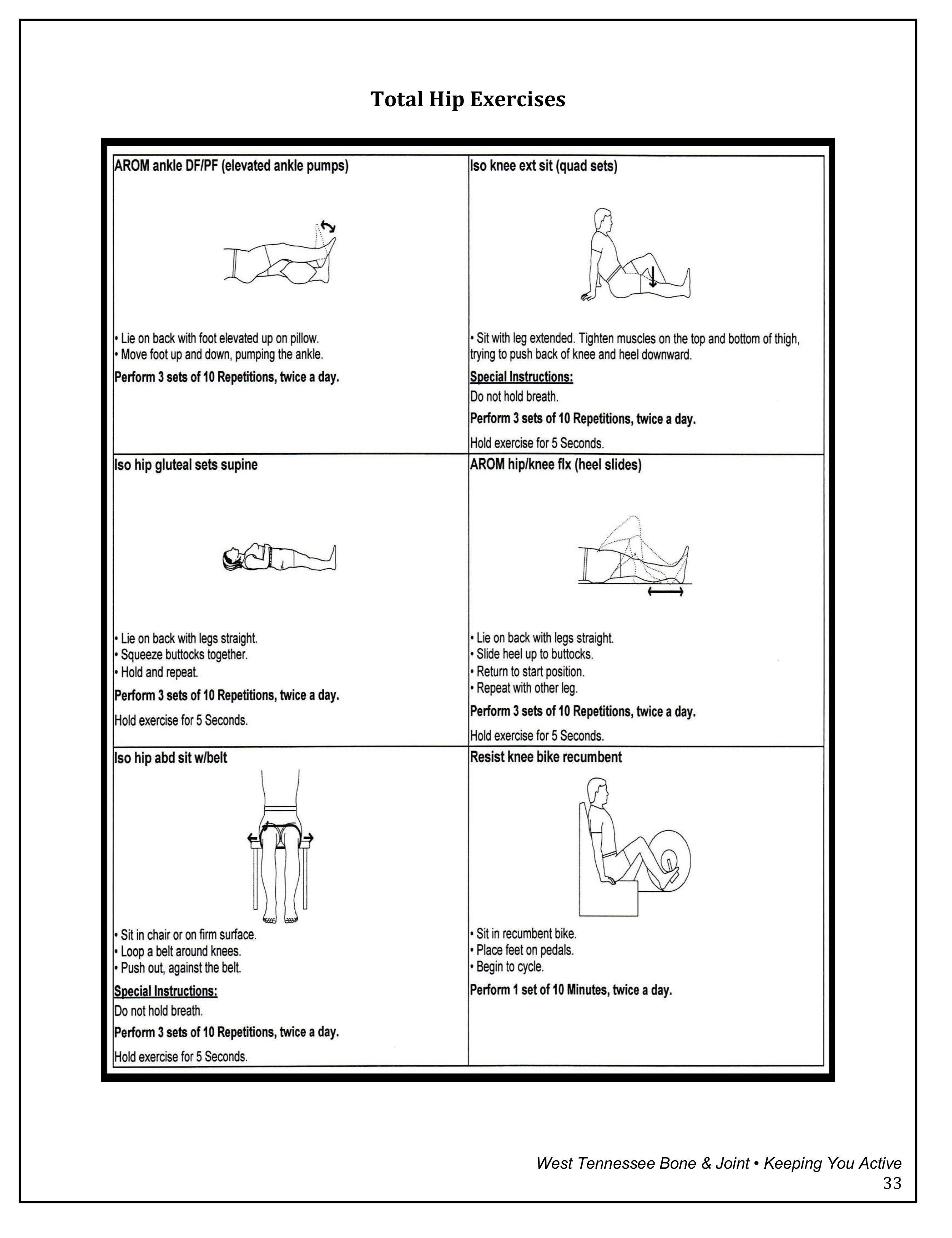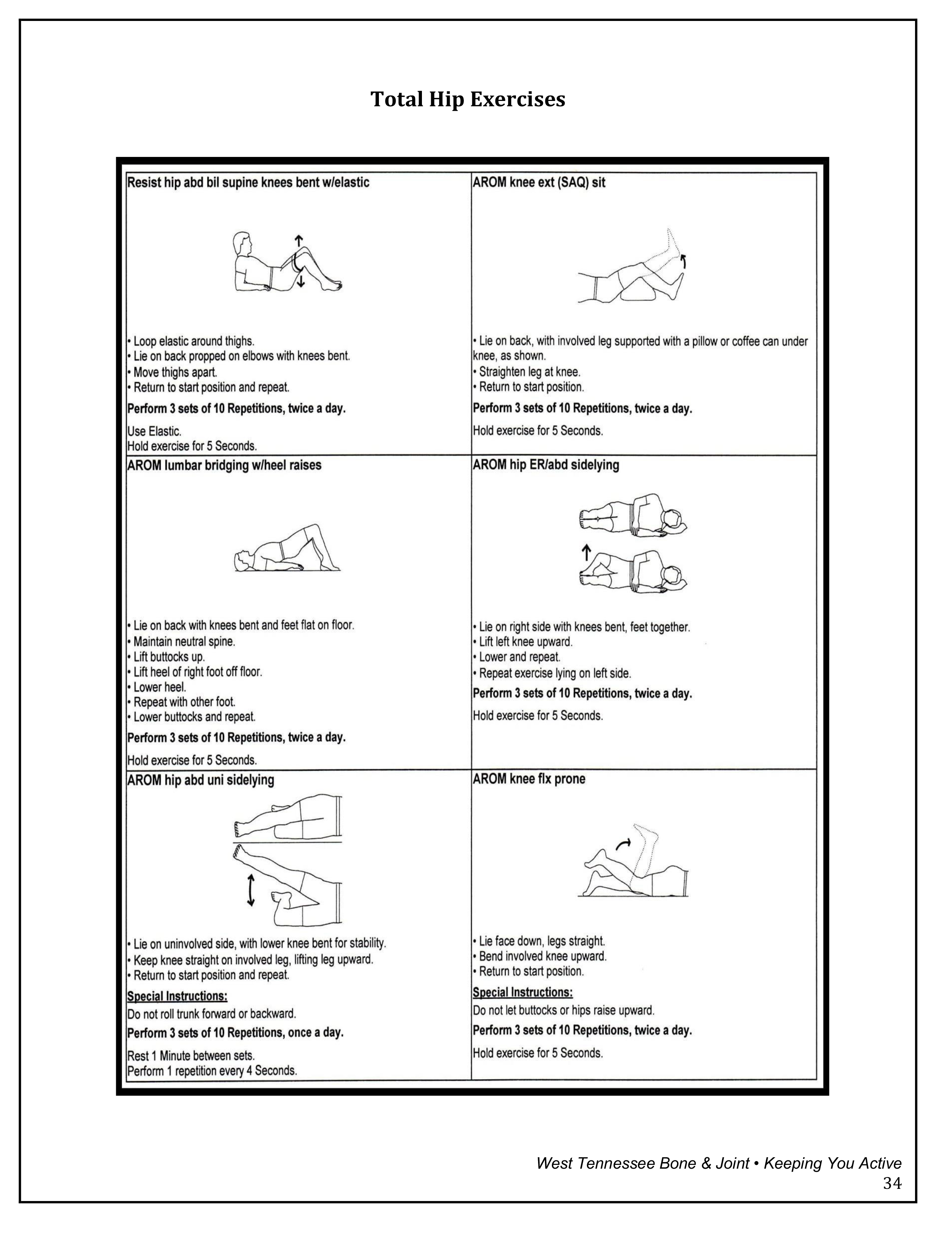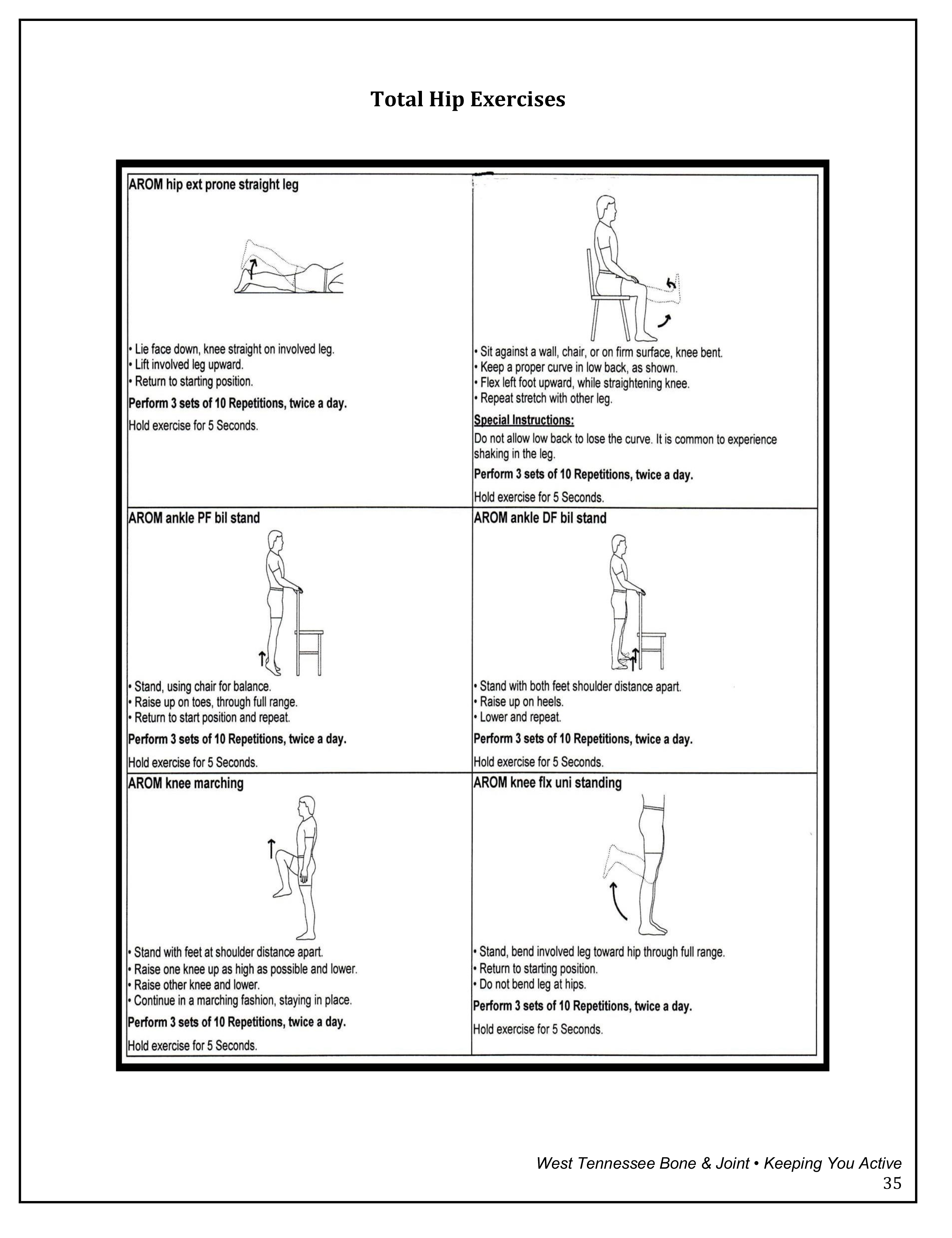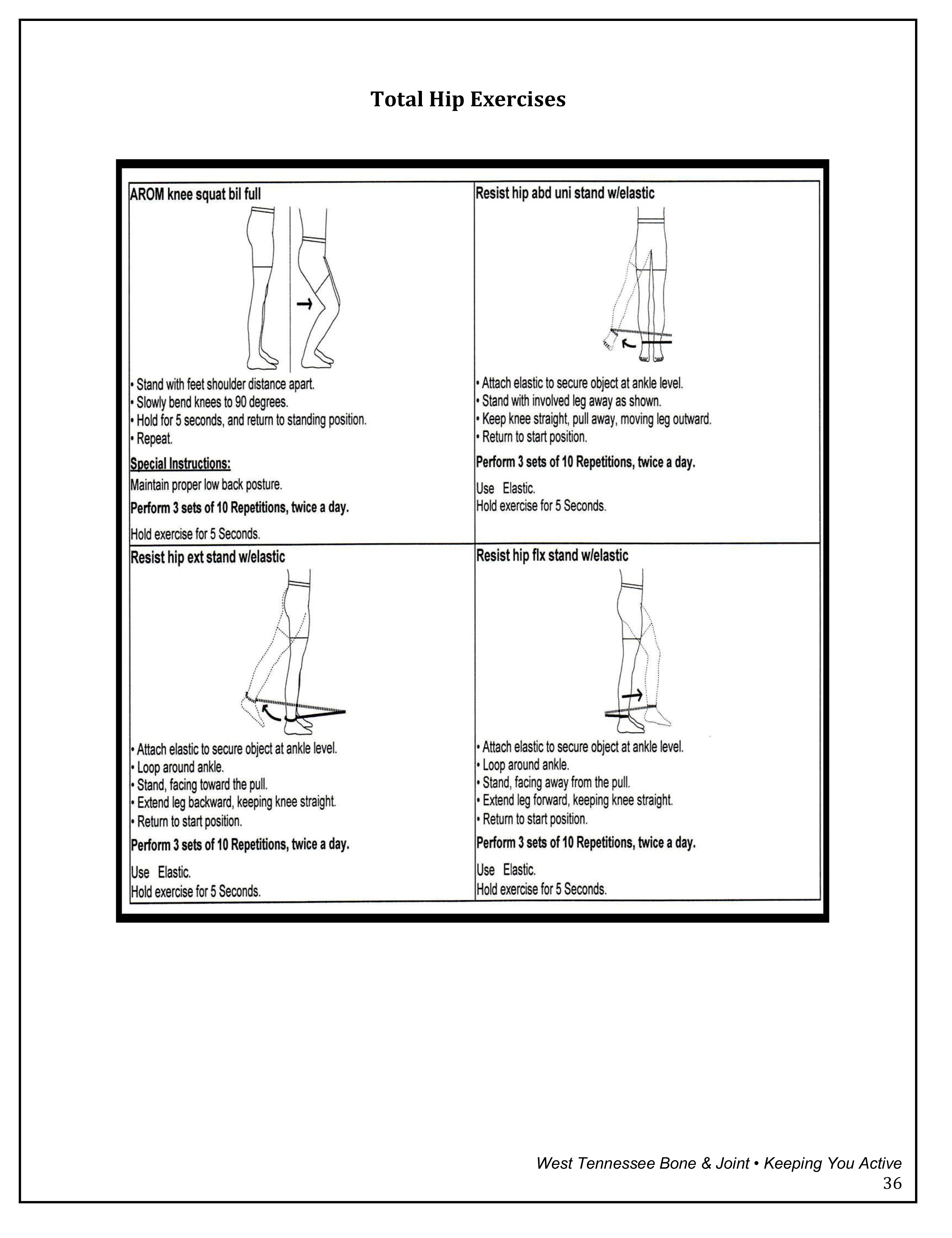What’s wrong with my hip?
Joint replacement surgery, also known as an arthroplasty, is done when a patient experiences severe, incapacitating pain due to osteoarthritis, rheumatoid arthritis, injury or avascular necrosis. The old joint is replaced with a new mechanical joint called a prosthesis.
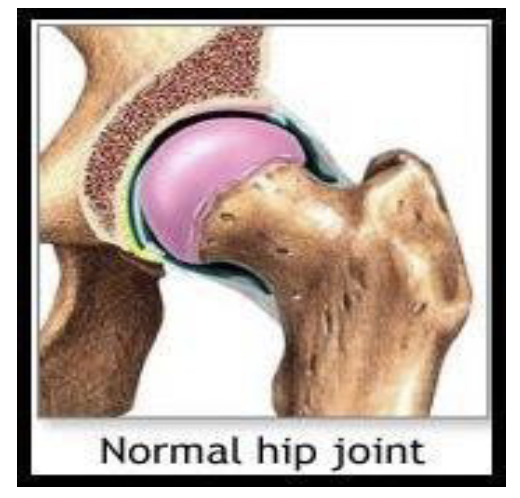 A healthy hip consists of a smooth ball on the end of the thigh bone which fits into the end of the hip socket to form the “ball and socket” joint. A layer of cartilage cushions the ends of these bones allowing the ball to glide easily within the socket.
A healthy hip consists of a smooth ball on the end of the thigh bone which fits into the end of the hip socket to form the “ball and socket” joint. A layer of cartilage cushions the ends of these bones allowing the ball to glide easily within the socket.
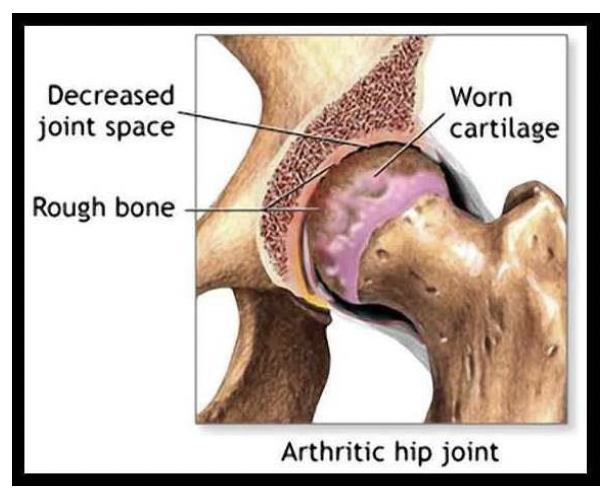 A problem hip can be the result of a wear and tear to the cushion of the cartilage in the hip joint due to osteoarthritis or other diseases. Without the cushion of cartilage, the joint surfaces become irritated and pitted as bone rubs against bone.
A problem hip can be the result of a wear and tear to the cushion of the cartilage in the hip joint due to osteoarthritis or other diseases. Without the cushion of cartilage, the joint surfaces become irritated and pitted as bone rubs against bone.
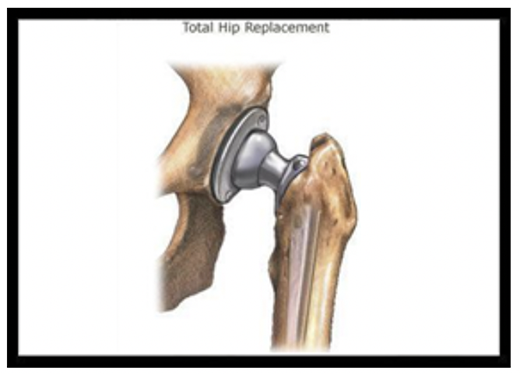 A hip prosthesis consists of a specially designed ball and socket that replace your worn hip joint. The ball and stem replace the worn ball of your thigh bone. A cup replaces the rough hip socket. The prosthesis has smooth surfaces that fit together and allow the ball to move easily and painlessly within the socket, much like a healthy hip.
A hip prosthesis consists of a specially designed ball and socket that replace your worn hip joint. The ball and stem replace the worn ball of your thigh bone. A cup replaces the rough hip socket. The prosthesis has smooth surfaces that fit together and allow the ball to move easily and painlessly within the socket, much like a healthy hip.
What are some of the risks involved in having a direct anterior hip replacement?
We want you to understand the benefits and risks of joint replacement surgery. The ultimate goal is for you to regain function of your hip with minimal pain and discomfort. Most people recover smoothly from surgery. Just like any surgery, there are risks involved in having a joint replaced. Some risks are more specific to total joint replacement, and others are risks of any surgery. Most patients have no complications. However, it is important for you to understand the risks and possible complications of a total joint replacement.
Blood clots
- During and after surgery, your activity level will decrease, which causes your blood flow to slow down.
- This can lead to clotting of the blood in your legs, which could potentially travel to your lungs, heart, and brain.
- In order to prevent this complication, the following measures are helpful:
- Compression stockings, compression sleeves or foot pumps during surgery and after surgery to improve circulation
- Ankle pump exercises after surgery
- Blood thinner medication
- Getting out of bed several times each day to help circulate your blood flow, starting the day of surgery or the next day.
Even with the best care, it is still possible for blood clots to form. Therefore, it is important for you to know the signs and symptoms of blood clots and to let the medical staff know immediately if you are experiencing any of these symptoms:
- Swelling
- Redness
- Pain
- Tenderness and warmth in the calf or lower leg
Infection is a possibility with any surgery.
- Infection can occur at the incision site or internally, around the prosthesis. It is an uncommon risk, but it can be a potentially serious complication.
- You will be given antibiotics during and after your surgery to help prevent this complication from happening.
- If, however, infection around your prosthesis does occur, additional surgery may be needed to remove the infected prosthesis and replace it with a new one.
- After surgery, we ask for you to take prophylactic antibiotics for any dental procedure, surgery or other medical procedure that may increase your risk of infection in your blood stream that could travel to your prosthesis. Additional information about prophylactic antibiotics will be provided to you by your surgeon.
Dental injury
- During your surgery, teeth could be potentially loosened, chipped or dislodged. If this occurs, please let your anesthesiologist know.
Prosthetic loosening, wear and/or breakage
- After many years, your new prosthesis could potentially loosen from the bone or you may experience some wear of your prosthesis. If severe, surgery may be needed to revise the joint to make it more stable.
- It is extremely rare for a metal or plastic prosthesis to break. However, if it should occur, surgery would be needed to revise the joint.
Nerve injury
- Nerve or blood vessel injury may occur during surgery.
- This is very uncommon, but if it does occur, these nerves usually will improve or completely recover with time.
- Numbness on the outside part of your hip after a hip replacement is normal and will usually improve with time.
Reactions to anesthesia or pain medications
- Please let us know if you have experienced a reaction to anesthesia from a surgery in the past or to any pain medications taken in the past.
Blood loss and transfusion
- Our team tries to minimize your blood loss during surgery. However, there is a small chance you may need a blood transfusion during or after surgery. Your age, overall medical health and your post-operative blood levels will determine if you need a transfusion.
Loss of limb
Death
Before surgery you may be asked to attend and/or obtain the following:
- Medical Clearance
- Cardiac Clearance
- Other Clearance
- Dental Clearance
- Pre-op Physical Therapy Evaluation & Home Exercise Program Instructions
- Total Joint Class
- Pre-Admit Appointment
Medical and dental clearance
Knowing your overall health helps give you better and proper medical care while in surgery and during your hospital stay. Therefore, you may be requested to provide pertinent information about yourself from your medical doctor to better assist in that care. This may include EKG’s, blood work, cardiac stress test, pulmonary function test, etc.
Because the threat of infection is a major risk factor to joint replacement, we may also request dental information regarding the status of your teeth and gums. A silent or unknown infection in your mouth could travel through your bloodstream and cause infection around your prosthesis, which could be devastating to your new joint. This would require additional operations, hospital stay and lengthy use of antibiotics. If you have not seen a dentist in the last twelve months, we may request that you make an appointment for a dental exam prior to surgery.

Frequently Asked Questions
1. What about my daily medications before surgery?
At the time of your pre-admission testing, the medications you routinely take will be reviewed with you. You will be advised to stop taking any medications before surgery, such as anti-inflammatory pills. You will also be told which medications to take the morning of surgery with a small sip of water. You will be given specific instructions about how soon before surgery you should stop taking blood thinning medications.
2. How long will I be in the hospital?
For joint replacement surgery, the majority of patients are able to go home the day of surgery.
3. What if I need extended care?
Your goal is to go home, as quickly and as safely as possible. However, a few patients are not yet capable of managing at home. Other arrangements may be made by your surgeon.
4. Will I have the opportunity to ask questions?
Questions and concerns will be addressed at the time of your visit with the surgeon. You will also have opportunities to ask questions during the time of your pre-admission testing. Also, feel free to call 731-661- 9825 (Jackson) or 731-644-0474 (Paris) for any further questions.
Positive approach to planning your joint replacement

Preparing mentally for surgery is just as important for you and your family or support person, as it is for your surgeon and the rest of the medical team involved in your hip replacement procedure. Because of medical advancements, total joint replacement surgery should relieve your pain and discomfort and improve your activity level. It is important to remember that the pain and activity limitations after surgery will be different than what you are experiencing now, and that they will be short term. A significant portion of the recovery process is using your new joint by walking and doing the exercises that your doctor orders.
Depending on your condition, your recovery and exercise plan will be tailored to meet your needs. Each patient recovers differently, and joint replacement revisions often progress at a slower pace than the initial surgery.
It is important for you to make a commitment to follow your doctor’s instructions and work on your exercise plan after surgery in order to benefit most from the joint replacement. If you or your family need support coping with surgery and recovery—either physically or emotionally—please talk with the staff. The improved lifestyle after recovery is worth the risk and stress of surgery.
A significant portion of the recovery process is using your new joint by walking and doing the exercises that your doctor orders.
Prepare for your procedure
Start your checklists to prepare for your hospital visit
Your physician’s office may provide you with this manual in advance of your surgery. Please take time to read your manual, ask any questions, and make sure that you take care of the things that need to be done several days or weeks ahead of the surgery date. Surgery is your primary path toward getting yourself back to being the person you want to be—so don’t let any unnecessary delays stand in your way!
Attend a joint replacement therapy visit
You should schedule a therapy visit two to three weeks before surgery when possible. Ask your surgeon’s office how to schedule your pre-surgical PT evaluation visit or call 731-410 2357 – Jackson or 731-407- 4738 – Paris.
Making arrangements
Taking care of a few items now will help make your return home smoother and safer! As we have discussed, total joint replacement surgery can relieve the pain and discomfort of your arthritic joint. However, there is a six-to-eight-week recovery period after your surgery during which you will experience different types of pain and discomfort. During this recovery phase, you will be using your new joint according to the instructions given to you at discharge and by your physical therapist as directed by your physician. We ask you to stay committed to these instructions and to your exercise plan. However, there are some limitations and arrangements that need to be made prior to surgery to ensure an easier recovery afterward.
Transportation
- You will not be driving initially after surgery. Your surgeon will instruct you when it is safe to resume driving. This could be anywhere from 1 to 6 weeks post-operatively.
- You may need to find someone to drive you to therapy and to your doctor’s appointments.
- You may also need someone to pick up groceries, medicines, etc.
Work
Arrange to be off work approximately four t0 six weeks, although you may be able to return sooner. The exact length of time will be determined by your doctor at your six-week post-surgical appointment. At that time, your doctor will consider your recovery rate and type of work you perform.
Prepare your home for your return
Kitchen
- Move most frequently used items to the counter so you can reach them without bending over or climbing (food, skillet, utensils, dish-washing items).
- Freeze meals or schedule to have a friend bring you meals for 4-6 weeks.
- You may find it helpful to stock up on prepared foods such as canned, boxed or frozen foods.
- Check to see if your local grocery store will deliver orders to you.
Bedroom
- If your bedroom is on the second floor, get creative!
- Your doctor may initially limit your trips up the stairs to only once a day after surgery.
- Find a space on the first floor to call your own for the first couple of weeks.
- Stock this area with things you need for the day, so you can rest.
Bathroom
- Put non-skid material in the bathtub or shower.
- You may want to purchase a tub transfer bench or shower stool if you have a tub shower.
- After a total hip replacement, you should use an elevated toilet seat.
“Fall-proof” your home
- Remove all throw rugs.
- Imagine using a walker and check for “trouble spots” in your home before your surgery.
- Check rooms for small objects, cords or stools that could cause tripping.
- Use a rolling cart to move items around and to keep them within easy reach.
- After surgery, use your prescribed walking aid at all times. Change positions slowly and avoid rushing to prevent loss of balance.
Other tips
- Rearrange your most frequently used items to a convenient level, somewhere between your waist and shoulder.
- Place a phone within easy reach wherever you are.
- Make sure that you have good lighting and that the light switch is within easy reach.
- Use a cushion to raise the seat in a low chair.

Help prevent infection…
- Taking a bath or shower is recommended the night before or morning of surgery.
- Do not apply lotion to the area where surgery is to be performed.
- In the hospital and at home, performing proper hand hygiene is essential.
- Wash your hands before eating and after using the rest room.
- Wash your hands after petting your animal(s).
Your defenses may be down after surgery, which is normal. Any step you can take to prevent infection is a step in the right direction.
In the hospital or at home, performing proper hand hygiene is essential.
Equipment you might need during your recovery
- Ask any questions you might have about obtaining equipment.
- Some insurance plans require a physician’s authorization.
- Walkers (with wheels) will be required by your physician. The need for additional equipment will be assessed post-operatively.
- Bring your walker to the surgery facility, but leave it in your vehicle for use on your way home.
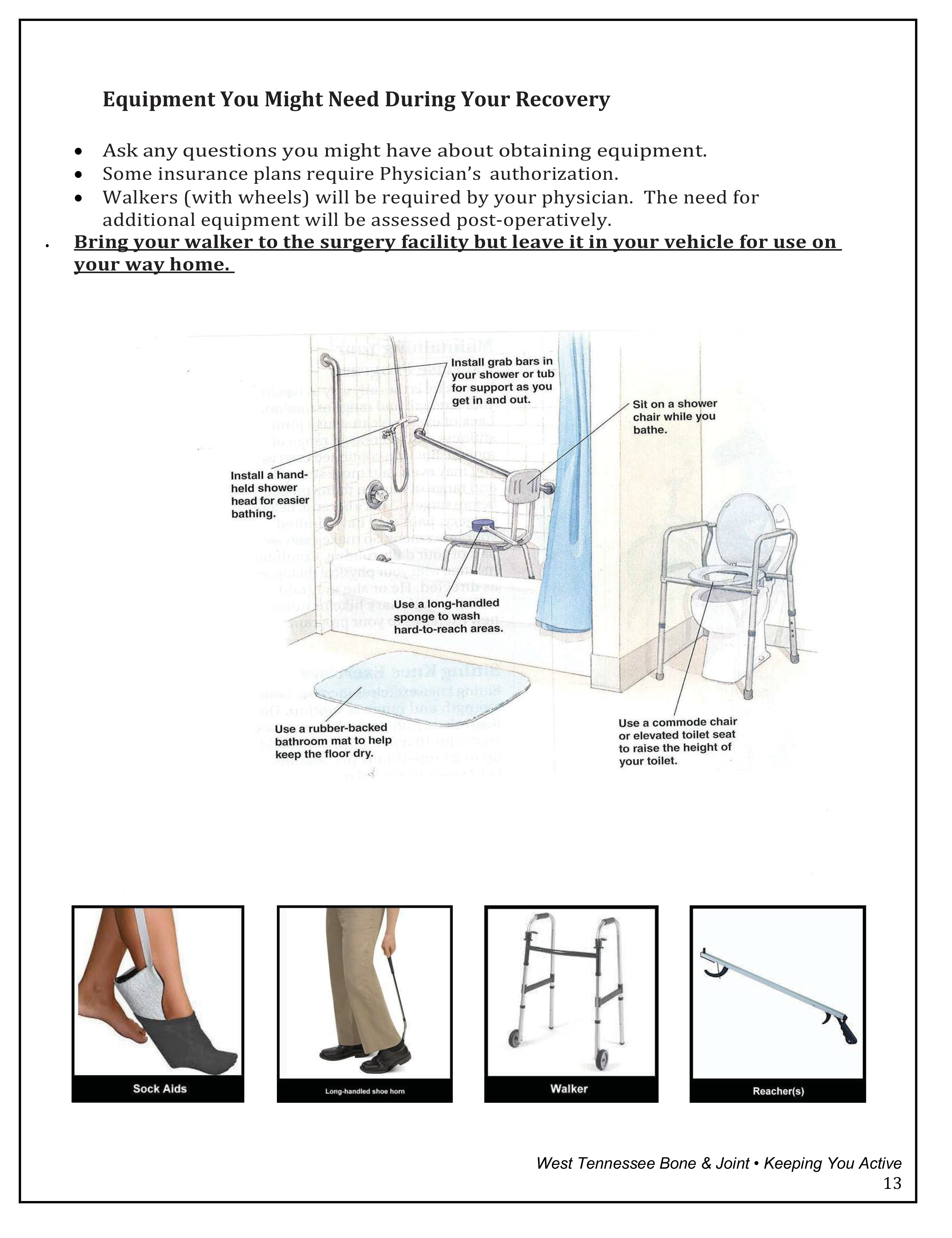
Prepare your home to aid your recovery
The friends’ and family’s role in your recovery
Your family and friends are very important in helping you during your recovery.
Examples of ways they can help you prepare:
- Stock up on canned and frozen or packaged food.
- Move your most frequently used items (such as food, skillet, extra toilet paper, soap, etc.) to cabinets between your waist and shoulder level, helping you avoid reaching and bending.
- Prepare a room for yourself with all the needed supplies so that you can rest during the day.
- Remove rugs and other clutter for safe walking.
- Run errands, grocery shop and drive you to follow-up doctor’s appointments.
- Arrange for your caregiver (Coach) to attend at least one of your therapy sessions in the hospital after surgery.
If your surgeon orders physical therapy, plan to go home and begin either Home Health or outpatient physical therapy the day after you are discharged from the hospital. If Home Health is ordered it is temporary with the goal of advancing to outpatient physical therapy.
What should I bring? What should I leave at home?
What should I bring to the surgery facility?
- Personal hygiene items (toothbrush, deodorant, lotions, etc.)
- Eyeglasses or contact lenses with case
- Loose-fitting shorts and T-shirts
- Rubber sole shoes
- Dentures, hearing aids, prostheses
- Any special equipment, including walker (leave in vehicle), and other daily activity aids, as applicable
- Your driver’s license and insurance/Medicare card
- A list of all medications you are currently taking. Please include dosage and instructions. Also, include over-the-counter medications and herbal supplements
- A caregiver (Coach), who should be with you in the hospital to be part of your care team, when possible.
What should I leave at home?
- Cigarettes and all tobacco products
- Jewelry, remove all body piercings
- Credit cards
- Large sums of money (anything more than $5)
- Keys
- As pleasant as we want your stay with us to be, you won’t need to bring much in the way luggage!
What else should I know?
- Do not eat, chew gum, or suck on or eat mints, drink or smoke after midnight the night before your surgery unless instructed to do so by your physician. You may brush your teeth and rinse with mouthwash. Your physician highly recommends you stop smoking/use of nicotine four weeks prior to surgery.
- Take any medicines as directed the morning of surgery with a small sip of water.
- If diabetic, check with your primary care physician about how to adjust your diabetes medication.
- Please leave your belongings (like your suitcase and walker) in your car until your room has been assigned.
- Surgery usually lasts approximately 2 hours.
- During your surgery, your family will be free to visit the cafeteria or other designated areas. Someone from surgery will contact them either on their cell phone or a hospital-assigned phone. Your surgeon will contact them after the surgery is complete.
- Narcotics may cause constipation. You are already prone to constipation because of surgery and lack of exercise. Increasing fiber intake while on narcotics may be a necessity. Over the counter stool softeners are available at your local drug store (i.e. Dulcolax, MiraLAX, etc.).
- It is important for you to breathe deeply to help your lungs clear and avoid complications, such as pneumonia. Bed rest, drowsiness, anesthesia and pain often keep you from taking normal deep breaths. Make use of the incentive spirometer you are given in the hospital and remember to use it.
Day of discharge: going home after hip replacement
Once you are stable enough to be discharged, you will go home. The majority of patients go home the day of surgery. Most patients will travel by car driven by a family member or friend. Please make these transportation arrangements before coming to the hospital for surgery. Insurances will not cover ambulance transportation to your home.
Discharge instructions
You will be given the following by the orthopedic nurses:
- Prescriptions for pain medicine as ordered by your doctor (these may have been electronically sent to your pharmacy).
- Instructions on medications to resume at home
- Your doctor may prescribe medication to prevent blood clots from forming, such as Aspirin, or prescription anticoagulants/blood thinners.
- Instructions on how to take care of yourself
- Instructions on wound care
- If your appointments have already been made, these will be reviewed with you.
- We request that you call your surgeon’s office and verify your follow-up appointment with the physician who performed your surgery.
- Your physician will discuss post-operative Physical Therapy with you to include need/frequency.
If there is any information that you do not understand, please ask the staff before you leave.
Call Us First (1-888-661-9825 –Jackson Office) (1-866-470-2663 – Paris Office) if you have:
- Increased redness, bleeding, pain or swelling on or around your incision
- Fever higher than 101◦ or as specified by your doctor
- Change in color or amount of drainage more than seven days after surgery
- Shortness of breath and/or chest pain, seek immediate attention at an emergency room
- Any other questions or concerns
Recovery
The past few weeks you have prepared for surgery, waited to enter the hospital, undergone surgery, learned to walk with your new joint and made plans for going home. Once you are stable enough to be discharged from the hospital, you will enter the recovery and rehabilitation phase of your surgery. For the next six to eight weeks, you will continue to heal and recover. You should balance periods of activity with periods of rest. Do not try to overdo or push yourself to the point of pain or exhaustion.
Activity
Follow the activity guidelines and exercises as instructed by your doctor or physical therapist. Always ice your hip after any extended activity or exercise.
Hip precautions
- Keep your toes pointed forward (do not rotate toward the inside or outside).
- DO NOT cross your legs.
- Use a pillow between your legs when sleeping only if this is more comfortable.
- DO NOT lean back beyond a normal standing position.
Walking
- Use your walker or crutches for each step when walking. Progress to the use of a cane when directed by your therapist or physician
- Walk daily for increasing distances, allowing for rests between activities.
Sitting
- Do not sit for longer than 30 minutes at a time. Get up, walk and change positions.
- On long car trips, stop at 30-minute intervals. Get out and move around. With the lack of movement, your hip may become stiff or swollen, and you are more prone to blood clots.
- Use a pillow or chair cushion on all low chairs.
- Use a raised toilet seat or bedside 3/1 commode chair if needed.
Sleeping
- Avoid sleeping on your side until your doctor tells you it is okay.
Stairs
- If you need to use stairs, we recommend making only one trip up and down each day. Be sure to hold on to the railing or another person for support when using the stairs. Work with your physical therapist before discharge on safe ways to use stairs.
Sports
- DO NOT use exercise equipment, whirlpools or spas until your doctor tells you it is okay.
- DO NOT participate in sports after your surgery until your surgeon tells you it is ok.
- Please talk with your doctor about the type of sports you like to do. You may eventually resume some sports that do not put your hip at risk, such as golfing, swimming, bicycling and dancing.
Driving
- DO NOT drive until your doctor tells you it is okay. This may be up to six weeks post operatively if surgery was on your right side, sooner if left side.
Care of your wound
- Unless otherwise instructed, once the hospital dressing is removed, it is okay to shower and wash (antibacterial soap) over incision when home.
- DO NOT apply any ointments to incision.
Swelling
- Swelling is common after surgery. Swelling may or may not occur in the hospital or after you are home and more active. The most common area for swelling is the foot, ankle, knee and sometimes the thigh.
Tips to Remember:
- You can modify and/or control leg swelling after surgery. Gravity drains the blood toward the heart to remove excess fluid. Lie on your back several times during the day with your legs elevated higher than your heart for at least 45 minutes.
- Change positions frequently during the day. You should not sit or stand for prolonged periods of time with your legs hanging down, as this position will create pooling of blood in the legs and will increase swelling. LET GRAVITY BE YOUR FRIEND! Gravity can help “drain” the blood toward the heart and remove excess fluid.
- Cold packs reduce pain and swelling. Use a cold pack often; up to 30 minutes per hour is acceptable. Cold packs may also be applied after exercise.
- Perform circulation exercises hourly and walk frequently
- Prolonged leg swelling can lead to problems.
Call Us First (1-888-661-9825 –Jackson Office) (1-866-470-2663 – Paris Office) if you have:
- Increased redness, bleeding, pain or swelling on or around your incision
- Fever higher than 101◦ or as specified by your doctor
- Change in color or amount of drainage more than seven days after surgery
- Shortness of breath and/or chest pain, seek immediate attention at an emergency room
- Any other questions or concerns
Sexual Activity
After hip surgery, many people are worried about resuming sexual activity.
Resume sexual activities
It is generally safe to resume sexual activity six-eight weeks after hip replacement surgery as long as you are not having significant pain or stiffness in your hip joint.
Effect of hip replacement on sexual relations
In reality, the pain and stiffness associated with your bad hip before surgery probably already interfered with intercourse. Since your surgery will help decrease most of that discomfort, you may now be more comfortable during sexual activity.
Safe positions and precautions
There are certain guidelines to follow:
- Avoid excessive outward or inward movements.
- DO NOT extend your leg past a normal standing position.
- DO NOT cross your leg toward midline.
Being on the “bottom position” initially is safer and more comfortable. You will be able to take a more active role in sexual activity as your hip heals. Generally, several months after your surgery, you may try any comfortable position. Talk with your partner. Be aware of the hip precautions and follow them at all times.
The facts about pain management
During and immediately following your surgery, you will receive pain medication by injections or through the IV. As you begin to recover from your surgery, you will be switched to oral pain medication. If you receive a femoral nerve block before surgery, your pain should be much more tolerable for the first 12 to 24 hours.
What will be your goal for pain control?
Some degree of pain is unavoidable. While you are in the hospital, you will be receiving pain medication to help control pain. It is important to tell your nurse if you are having pain. Don’t wait until the pain is severe. The more severe the pain, the harder it is to control. We will try to reduce your pain without compromising your ability to move, breathe deeply, or care for yourself.
Your nurse will ask you to rate your pain. A pain scale helps you rate your pain intensity. In the scale, 0 means no pain, and 10 is the worst pain possible. We cannot relieve all your pain, and you may feel some pain even with medications. However, we should be able to reduce it to a level of five or less. Be sure to mention if the pain suddenly increases or changes.
Important points:
- You will NOT be totally pain free.
- Pain medication is usually taken regularly. Don’t try to be a “hero” and wait too long or skip a scheduled dose in the first day or two after surgery.
- The longer you wait to take pain medicine, the worse your pain will become, taking longer to get under control.
- Contact your doctor’s nurse if your pain medication is not working or if you don’t like the way it makes you feel.
- Unrelieved pain robs your energy and takes away important time you could spend working towards a faster recovery.
- Your surgeon will prescribe pain medication to keep you comfortable. With strict federal laws regarding opioid use, it is important that you only take these medications as prescribed.
- You can take up to 3000 mgs of Tylenol unless otherwise directed by yourphysician.
Some other things you can do to try to control your pain
- Watching TV
- Changing positions
- Reading a book
- Listening to relaxation tapes
- Find out what works best for you
Physical therapy goals while you are at the hospital
- Walk as normally as possible with your walker or crutches. Try not to limp so that good natural movement is occurring in your new joint with each step.
- Walking at least two times a day and increasing your distance daily is expected starting the day after your surgery.
- Progress to sitting up in your bedside chair for meals.
- You should be able to get in and out of bed, in and out of a car, walk safely with an assistive device and safely make your way up and down steps with assistance from your family member if needed.
Equipment
- Compression Stockings: If ordered, they should be worn every day for the first three to six weeks. They help reduce swelling.
- Compression Sleeves/Foot pumps: These devices are used to help reduce the risk of blood clots in your lower legs.
Physical therapy pre-op visit
Please call 2 weeks before surgery date. (If you live out of town, try to schedule this on the same day as lab work.) Please call for an appointment.
West Tennessee Bone & Joint Clinic – Main
24 Physicians Drive, Jackson, TN 38305
731-410-2357
West Tennessee Bone & Joint Clinic – Paris
1006 Cornerstone Drive, Paris, TN 38242
731-407-4738
- Exercises will be issued to you by the Physical Therapist at your pre-op visit.
- Physical therapy exercises should be performed twice a day. If you attend physical therapy that day, then you just need to perform another set of exercises on your own during the day. If you do not attend physical therapy, then you have two sets of exercises to perform that day
- It is important that you attend your therapy visits. Therapy is a very important part towards your total joint healing.

Physical therapy total hip arthroplasty protocol
Goals:
- Ambulate without an assistive device safely, without Trendelenburg gait or antalgic gait patterns (limping)
- Climb stairs in a reciprocal pattern (one foot over the other) without upper extremities unless needed for safety
- Full functional mobility / independent with activities of daily living
- Avoid hip dislocation positions
Phase I (POD Day 2 – Week 3):
- The need and frequency of attending Physical Therapy will be determined by your surgeon.
- Wear TED hose as directed by your surgeon/nurse.
- Hip Precautions: should be followed for 3 months
- Use caution when sitting on very low surfaces where your knees are higher than your hips.
- Wound Care: Patient may have staples of just steri-strips depending on the surgeon.
- Patient may shower, no soaking in the bath. Use shower stool / tub bench for about 3 months.
- Staples removed at 14-21 days, and steri-strips applied for 7 days.
- When steri-strips are removed, begin scar massage with Vitamin E oil when wound is completely closed.
- Weight Bearing Limitations:
- Ambulation with rolling walker until equal weight distribution, balance is adequate for safety, and limited Trendelenburg gait/limp. Then, progress to straight cane if within surgeon’s limitations listed above. It is common for patients to feel “uneven” usually due to an abductor spasm, and it resolves over time. This will be addressed at the 6 week follow up appointment.
- Patient should do home exercise program 2x/day.
- Patient to walk at home 5 to 10 min / hr to increase circulation.
- Warm Up: Bike x 10 min., Recumbent Stepper x 10 min. Moist heat may be used across hip flexors to increase mobility.
- Mat Exercises/HEP: supine heel slides, LAQ, Quad sets, SAQ, hook lying abdominal isometrics, gentle hook lying hip flexion, partial double leg bridge.
- Standing Exercises: heel raises, mini squats, gait training, standing hamstring curls. NO weight machines until physician approval.
Phase II (Week 4 – Week 6):
- Progress ambulation from straight cane to no assistive device when patient is able to ambulate safely and without a Trendelenburg gait/limp.
- Progress mat exercises: bridging, clam in supine and SL, SL abduction, being figure 4 stretch.
- Progress standing exercises: forward step up/downs, balance activities, foam, SLS, squat progression, dynamic gait activities, side stepping, low hurdles, cardiovascular training.
- Patient should continue with HEP 2x/day.
- NO weight machines until physician approval.
- NO driving for 6 weeks unless off pain medicine and the straight cane.
- Teach patient 6 weeks stretches: single knee to chest with involved leg staying in one plane of movement, and sitting with involved ankle across opposite knee to assist with donning socks/shoes.
Phase III (Week 7 – 3 Months):
- Continue with home exercise program from your physical therapist 4x/week to continue to gain strength, stability, balance, endurance, and function. Able to use up to 5 lbs with mat exercises.
- Begin daily walks, starting with ¼ mile and gradually increase.
- Climb stairs in a reciprocal pattern with upper extremities only for safety.
- Able to begin upper body weight machines, only if sitting. No leg weight machines until approved by physician.
- For endurance: walk outside, walk on a track, water aerobics, recumbent/stationary bike, recumbent stepper, or elliptical machine. NO treadmill because of the compression on the new joint.
- Advance balance activities, lateral step ups 8-12 inches.
- Progress functional activity training.
Phase IV (3 Months – Years):
- Continue to do isolated hip strengthening exercises / home exercises program 3-4x/week. Focus on clams and SL abd.
- Able to use leg weight machines and low weight and gradually increase.
- Recommended Activities:
- Elliptical trainers
- Walking
- Recumbent bike/stepper
- Cycling
- Water aerobics
- Swimming – avoiding “frog kick” with breast stroke
- Low impact aerobicsYoga, Tai Chi, and Swiss ball activities may need to be altered to maintain hip precautions. Decrease combined movements at the hip
- Activities NOT Recommended.
- Running/jogging
- High impact aerobics
- Jumping rope/plyometrics
If you have any other questions, please contact our Physical Therapy office at 731-410-2357.
PT: Going home after hip replacement
Know Your Precautions
Due to the surgical approach, there are only a few precautions after anterior total hip replacement.
- Use caution when sitting on very low surfaces where your knees are higher than your hips. Initially it will be quite difficult to come to stance from this position.
- Avoid the bridge motion (lying on back with knees flexed and lifting hips).
- When lying, sitting, and walking avoid excessively turning surgical foot out to side.
- Avoid hyperextending your surgical hip (extending hip past body midline).
YOUR HIP PRECAUTIONS ARE FOR THREE MONTHS UNLESS OTHERWISE INSTRUCTED BY YOUR PHYSICIAN
Activity
Follow the activity guidelines and exercises as instructed by your doctor or physical therapist. Always ice your hip after any extended activity or exercise.
Physical Therapy
- Physical therapy is your job until your 4-6 week follow-up appointment with your physician.
- Once you are home, you will attend outpatient physical therapy if determined necessary by your physician.
- Physical therapy will focus on strengthening your muscles so that you can walk without a limp, climb stairs, and stand on your operative leg and maintain your balance.
- Physical therapy exercises should be performed twice a day. If you attend physical therapy that day, then you just need to perform another set of exercises on your own during the day. If you did not attend physical therapy, then you have two sets of exercises to perform that day.
Walking
- Use your walker or crutches while walking. You should have no increase in pain while walking. If you do, take off more weight from your new hip by placing more weight through your walker or crutches.
- As your muscles get stronger and your walking progresses, your therapist will instruct you to progress to a cane and then to no assistive device. These progressions should only be made if you can continue walking without a limp. If you are limping, please return to the previous device.
- Goal: While at home, try to walk 5 minutes every hour you are awake to keep your joint from getting stiff. You can gradually increase this time, but make sure to allow for rest between activities.
Sitting
- Do not sit for longer than 30 minutes at a time. Get up, walk and change positions.
- On long care trips, stop at 30 minute intervals. Get out and move around. With lack of movement, your hip may become stiff, swollen and you will be more prone to blood clots.
- Use a cushion or pillow on low chairs.
- Use a raised toilet seat.
- Do not rest in recliners. The recliner position does not aide circulation or help reduce swelling.
Stairs
- If you need to use stairs, we recommend making one trip up and down each day. Be careful and hold onto a railing or another person for support when using stairs.
Dressing
- When putting on pants or shorts, always put the surgical limb in first.
- Avoid breaking your hip precautions.
TED Hose
- Use of TED hose will be determined by your physician.
- Should be worn during the day on both legs for the first 6 weeks. They may be removed at night while sleeping.
- TED hose are important to control swelling and reduce the risk of blood clots.
- TED hose should be donned with help of a sock aid or another person in order to avoid breaking your hip precautions.
Sports
- DO NOT participate in sports during the first three months after surgery.
- DO NOT use whirlpools or spas until your doctor tells you it is okay.
- DO NOT use weight machines for the first three months after your surgery.
- DO NOT use leg weights over two pounds for the first six weeks after your surgery.
- You may eventually resume some sports that do not put your hip at risk such as golfing, swimming, bicycling, yoga and dance.
Sleeping
- Avoid sleeping on your operative side until your doctor allows.
- When you sleep on your non-operative side, place a pillow between your knees and ankles to keep your leg from crossing midline.
- Avoid every type of waterbed.
Sexual Activity
- After hip surgery, many people are worried about resuming sexual activity. The following guidelines are designed to address some of the more common issues. Please speak with your physician if you have any specific questions or concerns.
- Resuming sexual activity. It is generally safe to resume sexual activity 6 weeks after surgery as you are not having significant pain or stiffness in your hip joint.
- Effects of hip replacement on sexual relations. In reality, the pain and stiffness associated with your bad hip before surgery probably already interfered with intercourse. Since surgery will help decrease most of that discomfort, you may now be more comfortable during sexual activity.
- Safe positions and precautions. There are certain guidelines to follow:
- Do not bend at the hip more than 90˚.
- Do not move the leg toward the midline.
- Do not rotate the leg inward.
- Do not combine the above activities.
- Being in the “bottom position” initially is safer and more comfortable. You will be able to take a more active role in sexual activity as your hip heals. Generally, several months after your surgery, you may try any comfortable position.
Driving
- DO NOT drive until your doctor tells you it is okay. This is typically at six weeks.
Hip exercises
Preventing post-op infection
You have undergone a total joint replacement procedure. There are instances when infection in one part of the body may cause bacteria to circulate in your blood, possibly resulting in infection at the site of your implant. Therefore, it is essential you seek prompt treatment of infections anywhere in your body.

Good dental hygiene is important. You should see your dentist for regular dental care whether you are having a dental problem or not. Prompt treatment of any kind is important, including dental procedures such as the following:
- Dental extraction
- Periodontal procedures including surgery, sub-gingival placement of fibers/strips, scaling and root planning, probing, recall maintenance
- Dental implant placement and re-implantation of avulsed teeth
- Root canal instrumentation or surety only beyond apex initial placement of the orthodontic bands but not brackets
- Intraligamentary local anesthetic injections
- Prophylactic cleaning of teeth or implants where bleeding is anticipated.
Recommendations for antibiotic therapy from the American Association of Orthopaedic Surgeons are the following:
- Patients not allergic to Penicillin: Cephalex, Cephradine, or Amoxicillin 2 grams orally one hour prior to any dental or invasive procedure
- Patients not allergic to Penicillin and unable to take oral medications: Cefazolin 1 gram or Ampicillin 2 grams IM/IV one hour prior to any dental or invasive procedure
- Patients allergic to Penicillin: Clindamycin 600 mg orally one hour prior to any dental or other invasive procedure
- Patients allergic to Penicillin and unable to take oral medications: Clindamycin 600 mg IM/IV one hour prior to any dental or other invasive procedure.
No second dose is recommended for any of these dosing regimens.
The avoidance of bacterial contamination and infection should help reduce the risk of infection at the site of the total joint implant. Since prompt treatment is essential, please do not hesitate to consult your personal physician, your dentist or your surgeon should such a situation arise.
Concerns about addiction
You are taking narcotics because you hurt. When your pain from surgery decreases, your need for the pain medicine will decrease. The fears you or your family may have about addiction could:
- Prevent you from taking pain medicine
- Result in your “holding off” as much as possible between doses
- Result in taking lower doses of pain medicine when you still hurt.
All these result in needless suffering. Talk to the staff if you have concerns or fears about pain medication, a history of drug abuse, sensitivity to pain medication or low tolerance to pain.
Facts about addiction
- Addiction rarely happens in patients taking pain medicine to relieve postoperative pain (fewer, than 1% of patients).
- Most people are able to reduce or stop pain medicine when the pain decreases or disappears.
Taking pain medicine at home
- You will be given a prescription for pain medication.
- Plan ahead if you are getting low on pain medication. You may find it difficult to refill your prescriptions for pain medications during weekends, evenings or holidays.
- Within a few weeks, most patients can take Aleve® or Tylenol® for occasional pain. If, you’re still having a lot of pain at that time, it is important to discuss this with your surgeon.
Orthopedic nutrition

Nutrition plays an important role in your recovery from orthopedic surgery. Assuring optimum nutrient intake will speed up the healing process by providing the building blocks for tissue repair and growth. This will help you get back on your feet as soon as possible. It will also help minimize any complications such as infection.
Try to increase the variety of foods in your diet during this time in order to capture these vitamins, minerals and trace elements. Your body has an increased need for these foods after surgery. If you desire to receive any information about modified diets or if you have any questions regarding proper nutrition, you can request a Registered Dietitian to come see you while you are in the hospital.
The following are general guidelines to help meet these needs. Try to follow these guidelines for six-eight weeks after your surgery during the healing phase.
The Food Pyramid
Eating well is important to your health and your recovery. The USDA’S MyPyramid is your personal guide to healthy eating and physical activity.

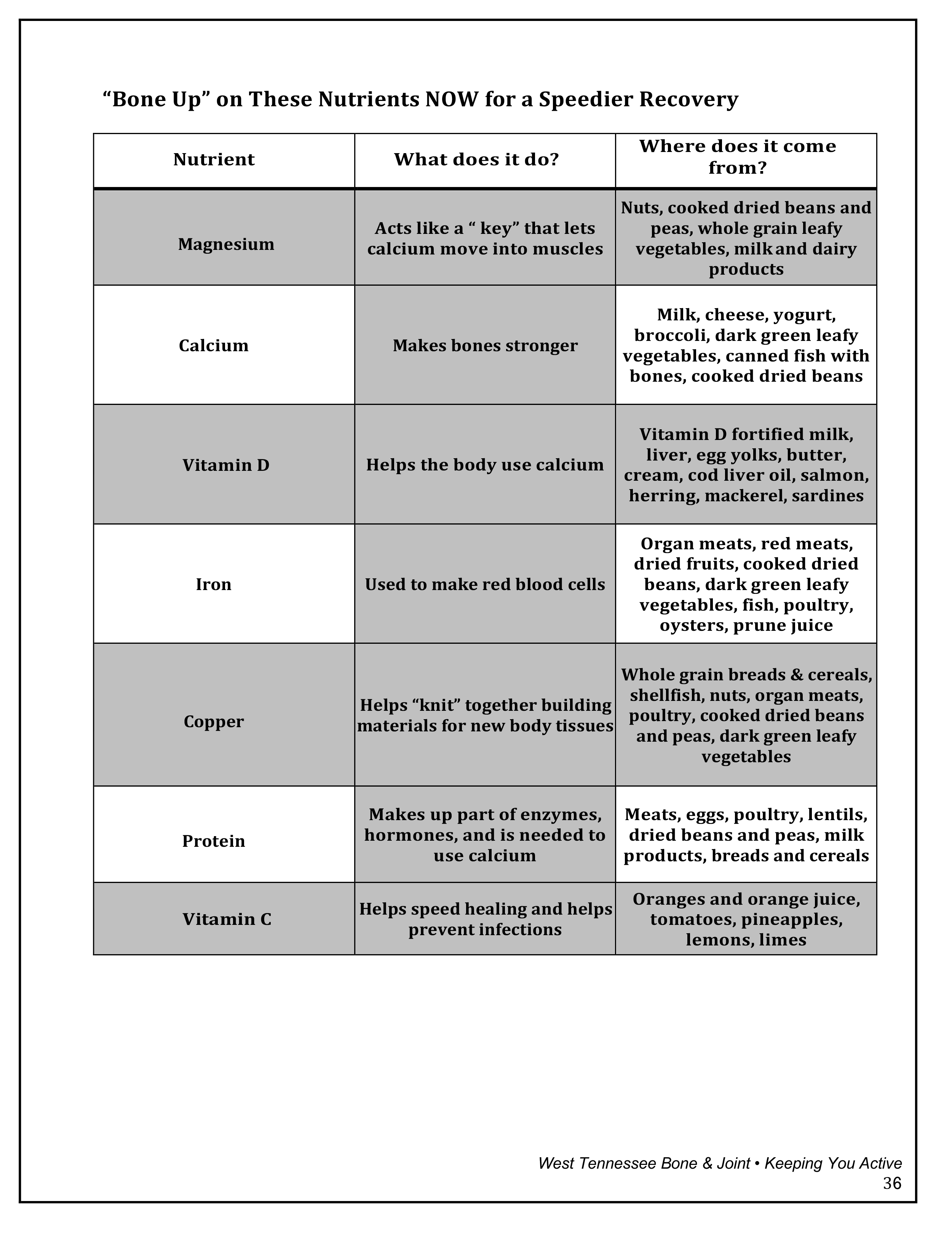
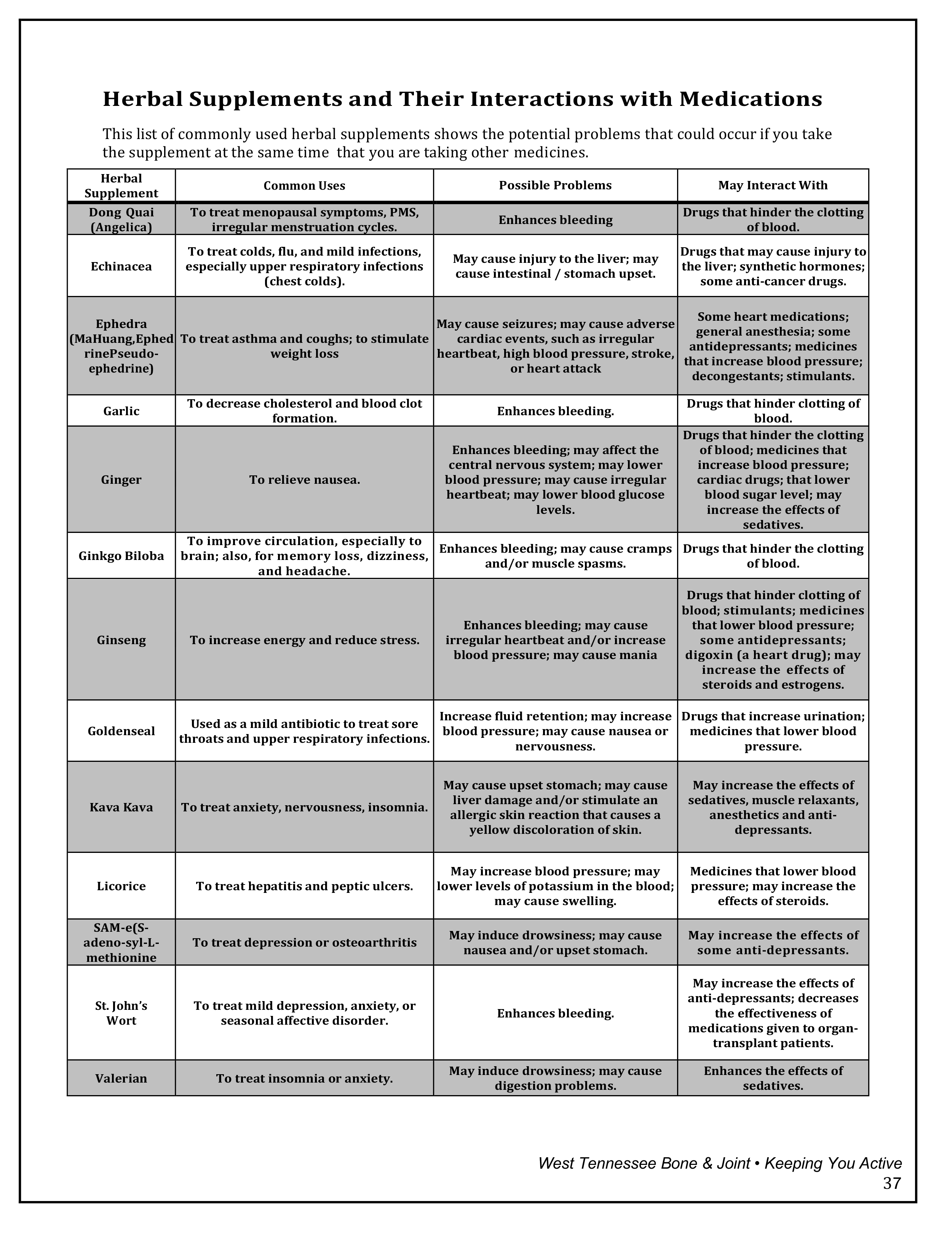
Download and print: checklist prior to surgery
Download and print: questions to ask
Reference numbers
Facilities/pre-admissions
Jackson-Madison County General Hospital
620 Skyline Drive, Jackson, TN 38301
731-541-6919
Jackson-Madison County General Hospital — North
367 Hospital Blvd, Jackson, TN 38305
731-541-6919
Physicians Surgery Center
207 Stonebridge Blvd, Jackson, TN 38305
731-661-6340
Henry County Medical Center
301 Tyson Avenue, Paris, TN 3824
731-642-1220
Physical therapy/rehab facilities
West Tennessee Bone & Joint Clinic – Main
24 Physicians Drive, Jackson, TN 38305
731-410-2357
West Tennessee Bone & Joint Clinic – Paris
1006 Cornerstone Drive, Paris, TN 38242
731-407-4738

